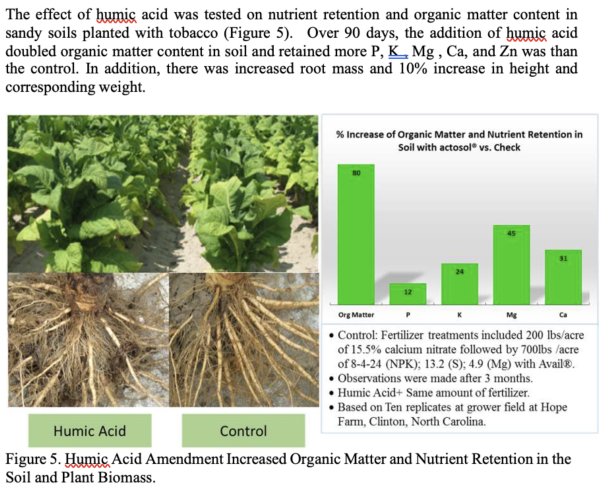By Daman S. Walia, PhD, and Samuel Lee Hancock, PhD
The UN’s Food and Agriculture Organization (FAO) warns that rapid worldwide soil erosion endangers the food security of the world’s growing population. “If we don’t act now, over 90% of the Earth’s soils could become degraded by 2050,” they warn. “Soil erosion can decrease crop yields by up to 50 percent. In addition, crops that do grow tend to be of a lower quality: misshapen, smaller, and less nutritious.”
Restoring carbon in the form of organic humic matter – ‘farming carbon’ – is essential to restoring the fertility of depleted soils. It is also one of the most powerful climate actions we can take and can be implemented by farmers right now. Soils are the fourth largest storehouse of carbon after sedimentary rocks, fossil fuels, and oceans. The fifth is air. Together with greenhouse gas emissions, the loss of soil carbon is an existential danger to humankind.
The solution is to rebuild the soil’s fertility and capacity as a carbon sink. In this article, we’ll outline how. We recommend the creation of a Rotary Climate Change Support Group to help Rotarians promote agricultural practices that durably store carbon in soils, help farmers qualify for carbon credits, promote sound public policy, and leverage other funding for these projects.
Imagine what 1.4 million Rotarians can accomplish! We challenge your club to engage ten farms in your region to implement this solution and demonstrate its benefits. Then catalyze the partnerships to scale it up rapidly.
The UN’s latest Climate Change Synthesis Report states that about a quarter of the Earth’s ice-free land area is subject to human-induced degradation. In 2022, global carbon dioxide emissions were 38.7 billion tons. If we are able to apply organic humic fertilizer even on 10% of the world’s cropland – 3.8 billion acres – we can capture 38 billion tonnes of CO2 per year: our current rate of emissions. Restoring soil carbon offers a path to net zero, a goal UN climate experts have set to avert the increasingly adverse impacts underway.
How humans have damaged soil’s ability to provide essential ecological services: Currently, 33% of the world’s soils have lost much of their organic matter through the historical expansion of agriculture and pastoralism and subsequent land-use conversion from native ecosystems (e.g., peatlands, forests, grasslands) to arable land. This has resulted in a decline in soil structural stability, increased erosion risks, and reduced water storage and nutrient supplies.
The Green Revolution of the ’50s and ’60s exacerbated these losses. The massive use of chemical fertilizers and disease control chemicals being produced in WWII factories resulted in a dramatic growth in the global food supply, but the intensive farming this generated, the use of mechanized farming equipment, and runoff have also increased water pollution and soil degradation through the loss of organic matter. Crop yields have accordingly declined in proportion to inputs. Farmers are earning less and less for every unit of the costly chemicals they are applying.
The melting of permafrost, which comprises 16-23% of the earth’s total land area, raises concerns over the risk of massive releases of carbon dioxide and methane from soils that are currently frozen. However, the soils of these vast lands, rich in stable organic humic matter, could be harnessed for habitation and cultivation to increase food supply.
The solution: divert coals from burning to farming: Organic humic substances are now being derived from natural sources enriched in humic matter, notably, lower-rank coals formed over geological times from the humification of decaying buried plants. These organic humic fertilizers are increasingly proving effective worldwide in increasing crop yields by 20% or more.
 Humic matter is the most active form of organic matter in soils. It imparts biological, chemical, and physical benefits for the growth of plants and soil fertility. Humic matter promotes increased root formation and top growth. Larger, healthier plants increase the rate of photosynthesis, capturing more CO2 from the air and durably sequestering it in soils. Humic matter makes crops more drought-resistant by increasing the soil’s water-holding capacity. It also increases plants’ tolerance to increasing salinity in soils and waters, even turning calcareous, sandy desert lands into fertile soil. The use of these fertilizers is also increasing the nutritional content – particularly protein – in the resulting crops.
Humic matter is the most active form of organic matter in soils. It imparts biological, chemical, and physical benefits for the growth of plants and soil fertility. Humic matter promotes increased root formation and top growth. Larger, healthier plants increase the rate of photosynthesis, capturing more CO2 from the air and durably sequestering it in soils. Humic matter makes crops more drought-resistant by increasing the soil’s water-holding capacity. It also increases plants’ tolerance to increasing salinity in soils and waters, even turning calcareous, sandy desert lands into fertile soil. The use of these fertilizers is also increasing the nutritional content – particularly protein – in the resulting crops.
Organic humic fertilizers made from natural sources including coals are approved in the USA by the USDA for organic food production and by the US EPA for combining with pesticide-plant protection chemicals to improve their efficiency and delivery. Similar approvals have been given worldwide. Using these products increases crop yields and farmers’ income. The poster above was shared by Rotarian Najar Nyakio Munyinyi. It comes from a nonprofit called Seedball Kenya, one of several NGOs that use charcoal to grow trees.
Another great opportunity for farmers is the sale of carbon credits being sought by companies to offset their emissions. With these incentive programs, farmers can realize income equal to or greater than the revenues they currently generate from their crop sales.
Presently 27 countries impose carbon tax, and 64 have established carbon pricing initiatives. Boomitra provides satellite imagery for validation of carbon credits especially on farmlands.
Farmers’ carbon credit revenue can be increased even further by planting trees on farms, whose land averages 10-20% non-crop areas. The UN Clean Development Mechanism guidelines, per the Kyoto Protocol, state that trees one meter and higher planted only on 10% of land area and with 30% canopy qualify for carbon capture. The USDA reports that an acre of mature trees can capture 6 tons of carbon dioxide and release 4 tons of oxygen a year. Planting trees on actively managed lands including farmlands will result in increased tree survival and prevent the kinds of forest fires we are experiencing today from trees becoming dry and combustible in forests suffering increasing droughts.
Thus, for farmers to farm carbon as well as increase food production is a game-changer opportunity, contributing to increased food supply at lower costs even with increasing droughts.
We’re seeing a rapid evolution in carbon markets and methods for validating and monetizing agricultural projects to qualify for credits. There’s an intense debate over the credibility of some of the methodologies and it’s important to prevent greenwashing. The proposed Rotary Climate Change Support Group could provide a major service in the following ways:
- Provide guidance to Rotary projects on incorporating carbon mitigation approaches and durably storing carbon in soil.
- Prepare guidance documents for quantifications of carbon lifecycle analysis of the projects and how to input them into the iRotary App.
- Help farmers obtain verification of the carbon credits resulting from the projects from accredited organizations, monetizing the carbon credits for the project site owners so the projects will become self-sustaining long term.
Benefits in mitigating climate change: We’re proposing the reallocation of the large resources of coals available worldwide: not only for agriculture but also for water cleanup, waste recycling, and a myriad of other proven uses. As we divert fossil fuels from burning to farming, oceans will absorb less carbon dioxide because farms will increase their capacity to absorb excessive levels in air and store it durably in soils. Shifting the use of coals away from burning offers an opportunity to fast-track the reduction of atmospheric carbon. Doing this on a global scale will increase the food supply for growing populations while rebalancing four of our planet’s largest carbon storehouses: fossil fuels, ocean, land, and air.
The Lawson Farm in Gordonsville, Virginia has demonstrated the practicality of this approach over ten years. At the outset, the farm’s soil had high amounts of residual salts from the excessive use of chemicals. Lawson Farm soil had an average of 1% organic content. By March 2023, soil test reports showed organic matter levels had reached 6.4-7.5% and nutrient reserves increased by 25%, which means more fertilizer was retained in soil from previous applications and will be available for the next crops. This prevents pollution and saves money on costly fertilizers.
Farmer Larson has increased his soybean, wheat, and sorghum yields by 20-50% while cutting his use of other fertilizers by 50%. He is achieving this without irrigating, depending only on rainfall. Lawson Farm also utilizes the practice of plowing in the crop residues which are lower in dry matter or biodegradables, amounting to, on average, two tons per acre. Combining these residues with organic humic fertilizer facilitates the multiplication of soil microbes for faster incorporation in the soil organic matter.
The farm is now able to capture a net 10 tons of CO2 per acre per year by applying only 10 gallons of organic humic fertilizer. In other words, each gallon of organic fertilizer facilitates removing one ton of CO2 from the air.
This nexus of agriculture and coal offers a path forward for a new green revolution for ensuring food security while preventing huge disruptions to worldwide economies.
I presented this strategy on August 30, 2023 to the ESRAG Projects + Webinar with Rotarian and fellow ESRAG member Dr. Samuel Hancock. You can share the talk with your Club from this link. It explains proven approaches that are practical, and economic value-generation that will result in meeting the world’s critical needs at lower costs and with less pollution. We are glad to correspond with you and help you to develop soil regeneration demonstration projects in your region. You can reach me, Daman S. Walia, PhD, at dwalia@arctech.com and Samuel Hancock, PhD, at emeraldplanet1@gmail.com
Dr. Daman Walia has spent his career developing alternate, sustainable uses of coal including the soil remediation strategies described in this article. He holds a doctorate in mineral science from Miami University in Ohio, and is the founder of Arctech, Inc. which has received three trademarks for commercial use of organic humic products and approvals from the US EPA and US Department of Agriculture. While not a Rotarian, he was indoctrinated into the Rotary concept of “service above self” as a little boy by his grandfather, Mr. Bakshih Singh Ahluwalia, President of the Rotary Club of Nabha, India, who assigned him to serve tea at meetings of the club.
Rotarian Samuel Lee Hancock, PhD is Executive Director of the non-profit EmeraldPlanet in Washington, DC. EmeraldPlanet television programs are simulcast weekly to over 2,000 stations globally. He holds a doctorate in management, international economics, and public policy from Virginia Tech.
